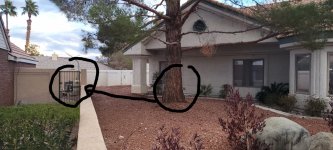Damp Soil Near Pool Equipment
- Thread starter lasvegas1976
- Start date
You are using an out of date browser. It may not display this or other websites correctly.
You should upgrade or use an alternative browser.
You should upgrade or use an alternative browser.
The neighbor agreed to cut down the tree (in writing via email).I use this App all the time on my iPhone -

PictureThis App - Online plant encyclopedia and plant identifier
PictureThis App: Online plant encyclopedia and plant identifier. Identify plants with a snap, Auto problem diagnosis, Detailed plant care guides.www.picturethisai.com
It has been super accurate at detecting all types of plants. And I believe they've expanded it to bugs, pests, plant damage, etc., (in the paid version of course). It helps with making good plant choices too as it gives you plenty of details on water and sun needs as well as temperature zones and pet toxicity.
I didn't even ask to have it cut down (felt it might be too forward), but I did mention that I'm not going to pay for future repairs if their tree is found to be at fault. They basically wrote back that they would remove the tree to solve all problems.
- May 23, 2015
- 25,707
- Pool Size
- 16000
- Surface
- Plaster
- Chlorine
- Salt Water Generator
- SWG Type
- Pentair Intellichlor IC-60
The neighbor agreed to cut down the tree (in writing via email).
I didn't even ask to have it cut down (felt it might be too forward), but I did mention that I'm not going to pay for future repairs if their tree is found to be at fault. They basically wrote back that they would remove the tree to solve all problems.
Wow. That was an interesting response on the part of the neighbor ... maybe he hates the tree too ...
They already cut it down. That's the good news.Wow. That was an interesting response on the part of the neighbor ... maybe he hates the tree too ...
The bad news, his landscapers think the pine tree - which is 15 feet away - is the actual culprit. I'll have to see when the pool guys trentch further out at the end of January.
Tell them to chop it down while they're in the tree chopping down mood.The bad news, his landscapers think the pine tree - which is 15 feet away - is the actual culprit.
- May 23, 2015
- 25,707
- Pool Size
- 16000
- Surface
- Plaster
- Chlorine
- Salt Water Generator
- SWG Type
- Pentair Intellichlor IC-60
I think you all should step away from the chainsaw and relax ... I have no problem with tree removal but your not going to solve root issues unless you chop down every tree within 1/4 mile radius and that just not realistic. Once you get the leak found and fixed, you can dig out the area, remove the roots, and then apply a root killer compound (eg, tebuthiuron contained herbicides) to the fill soil. That will kill the roots and keep anything from going back.
You can see how close his pine tree is to my pool equipment. There is nothing else around that has roots even close to reaching that area or being a danger to the pool equipment.I think you all should step away from the chainsaw and relax ... I have no problem with tree removal but your not going to solve root issues unless you chop down every tree within 1/4 mile radius and that just not realistic. Once you get the leak found and fixed, you can dig out the area, remove the roots, and then apply a root killer compound (eg, tebuthiuron contained herbicides) to the fill soil. That will kill the roots and keep anything from going back.
I made an offer to have my landscapers cut that tree down, at my expense, and the neighbor accepted.
Attached are two photos from when I had to replace 17 feet of sewer line just a year ago. Those pine tree roots are almost as big as the sewer line pipe, which was all cracked and bashed up from the pine roots growing in the area - and that pine tree was 20 feet away. I cut that pine down really quick.
Attachments
- May 23, 2015
- 25,707
- Pool Size
- 16000
- Surface
- Plaster
- Chlorine
- Salt Water Generator
- SWG Type
- Pentair Intellichlor IC-60
Wow. Yeah, western pines are horrible for root growth. And when they get sick or beetle infested, you can easily lose the entire tree in less than a season. We had a western pine at my kids’ school go totally brown and dead in less than a year. It was easily a 40ft tall tree with a huge trunk. Beetles got to it and no one paid attention to the warning signs. Took a full crew with a bucket truck, chainsaws, and a diesel wood chipper to take the pine down. After that, all the could do was grind the stump down to a few inches below grade and then bury it with top soil and stone. The knuckle and tap root remains.
It’ll be good that you’re getting rid of it.
It’ll be good that you’re getting rid of it.
It's very hard to remove their stumps, because you have no idea what the roots may have latched on to several feet down or if the roots are growing under something. You rip out a stump and end up pulling some pipes, wiring or gas lines with it. All you can do is cut it down to ground level and cover it up. Pines are toast from the moment you cut it down. The roots stops growing and whatever roots that remain will take years, even over a decade, to fully dissolve (especially the big fat roots).Wow. Yeah, western pines are horrible for root growth. And when they get sick or beetle infested, you can easily lose the entire tree in less than a season. We had a western pine at my kids’ school go totally brown and dead in less than a year. It was easily a 40ft tall tree with a huge trunk. Beetles got to it and no one paid attention to the warning signs. Took a full crew with a bucket truck, chainsaws, and a diesel wood chipper to take the pine down. After that, all the could do was grind the stump down to a few inches below grade and then bury it with top soil and stone. The knuckle and tap root remains.
It’ll be good that you’re getting rid of it.
- May 23, 2015
- 25,707
- Pool Size
- 16000
- Surface
- Plaster
- Chlorine
- Salt Water Generator
- SWG Type
- Pentair Intellichlor IC-60
My brother has a bald cypress tree in the middle of his backyard. The tree is massive and provides a lot of shade but it drops so much stuff all season long. Makes a huge mess. The roots also grow in the surface and he has several large knuckles popping up out of the ground around it. He tried cutting a few out and, in the process, pulled up part of his irrigation lines. Had to have them repaired. The landscaper told him to stop going after the roots as it’s a fool’s errand and he would just do more damage than good. He offered to remove the tree for quite a hefty sum of money so my brother has just decided to live with it.
The black spot (Lower arrow) looks suspicious.
I would dig at the top arrow as the leak is likely at the 90 on the pipe with the black spot.
View attachment 466712
You were right, the leak was right there. There was a crack at the tee.
That line is connected to the main water line, it feeds the auto-fill and feeds the backyard irrigation stations. So it was a simple fix just by turning off the water line connection.


Last edited by a moderator:

Become a TFP Supporter
Help Support TFP Trouble Free Pool is run by a dedicated group of volunteers that … Read more…
I've got my gold plaque.
Become a TFP Supporter
Help Support TFP Trouble Free Pool is run by a dedicated group of volunteers that … Read more…www.troublefreepool.com
- May 23, 2015
- 25,707
- Pool Size
- 16000
- Surface
- Plaster
- Chlorine
- Salt Water Generator
- SWG Type
- Pentair Intellichlor IC-60
That leak I believe has been going for a very long time, there was a lot of black moss in that area ( I first noticed the dampness in that area around 2021 at least). It wasn't a big leak by the looks of it. There were two small sprays of water at the tee, but when it's going 24 hours a day and 7 days a week.... Weird thing is, my water meter was barely moving - if at all - when I was trying to track this leak down, which made me positive the leak was one of the pool pipes. My bill last month was only 3 dollars more than last year, and that's with higher water rates, so yeah this was a weird one.Check your next water bill carefully …
- May 23, 2015
- 25,707
- Pool Size
- 16000
- Surface
- Plaster
- Chlorine
- Salt Water Generator
- SWG Type
- Pentair Intellichlor IC-60
Cracks in pipes act very differently when encased in hard caliche and clay soils like we have in the desert. If the crack is small enough the leak will start and stop based on soil saturation and temperature levels. I saw that in my own leak where there would many normal months in a row and then an unexplained jump on the water bill. Once the pipe was freed from the soil, then the leak was continuous and obvious.
Once I really dug the hole out, and the leak was more exposed (but not fully exposed), that's when I saw the water meter move a little, stop, move a little, stop for over a minute, start slowly moving again.Cracks in pipes act very differently when encased in hard caliche and clay soils like we have in the desert. If the crack is small enough the leak will start and stop based on soil saturation and temperature levels. I saw that in my own leak where there would many normal months in a row and then an unexplained jump on the water bill. Once the pipe was freed from the soil, then the leak was continuous and obvious.
The leak appeared to have a similar look to the below example.
Attachments
an1vrsy
Bronze Supporter
- Jul 10, 2018
- 1,238
- Pool Size
- 26000
- Surface
- Plaster
- Chlorine
- Salt Water Generator
- SWG Type
- Pentair Intellichlor IC-60
My question is a little off topic but you posted the above, so my questions is: How do you heat your house here in Las Vegas without natural gas? Dec - April my gas bill averages $110. The other times of the year it is about $12 - $17Hopefully that fizzing noise is not the gas line, although my gas bill is usually 13 bucks a month (only pool heater and dryer use gas on the whole property).
I have 5 HVAC systems in my home. They are all electric/heat pump systems.My question is a little off topic but you posted the above, so my questions is: How do you heat your house here in Las Vegas without natural gas? Dec - April my gas bill averages $110. The other times of the year it is about $12 - $17
an1vrsy
Bronze Supporter
- Jul 10, 2018
- 1,238
- Pool Size
- 26000
- Surface
- Plaster
- Chlorine
- Salt Water Generator
- SWG Type
- Pentair Intellichlor IC-60
Please tell me you also have solar energy. I couldn't imagine your electric bill without it.
edit: excuse me for being nosey.
edit: excuse me for being nosey.
Thread Status
Hello , This thread has been inactive for over 60 days. New postings here are unlikely to be seen or responded to by other members. For better visibility, consider Starting A New Thread.






